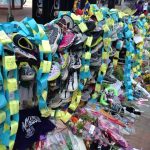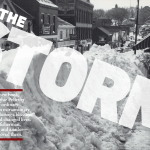The Birth of a Legend
To those of us who were around during World War II, and even as late as the 1970s, the name Kilroy is as familiar as MacArthur, Truman, and Lyndon Johnson. During those years, the words “Kilroy Was Here” were penciled on rest room walls, carved on picnic tables, painted on bridges — you name it. […]
To those of us who were around during World War II, and even as late as the 1970s, the name Kilroy is as familiar as MacArthur, Truman, and Lyndon Johnson. During those years, the words “Kilroy Was Here” were penciled on rest room walls, carved on picnic tables, painted on bridges — you name it.
Everyone knew his name, but no one seemed to know who Kilroy really was or if he really was. No one, that is, except the workers at the Fore River Shipyard in Quincy, Massachusetts. They knew he was James J. Kilroy, born on September 26, 1902, in Boston’s South End. He attended Commerce High School, he served as state representative and Boston city councilor from Roxbury, and, when the war started for us in 1941, he became a rate setter or “checker” at the shipyard, working on the battleship Massachusetts (now berthed at Fall River), the heavy cruiser Baltimore, and dozens of troop carriers.
“It was Jim’s job to go around and count the number of holes a riveter had filled,” explained his widow, Mrs. Margaret Kilroy to YANKEE writer Robert W. Cubie, whom we sent to Quincy in 1970 to find out how this American legend came to be. “The riveters were on piecework and got paid so much for each rivet. After Jim had counted the rivets put in by a certain worker, he’d put a checkmark next to them so that they wouldn’t be counted twice. “A few dishonest men, ” Mrs. Kilroy continued, “would know when Jim was going off duty, and they would sometimes erase his checkmark. The checkers on the next shift would come through and count the rivets again, which meant those riveters would get paid twice.”
“One day, Jim heard his foreman ask one of these dishonest riveters if Kilroy had been there. When the man said no, my husband was furious, because he knew he’d already checked that man’s rivets. So he took his chalk and wrote ‘Kilroy Was Here’ in letters too large and tool bold to erase.”
So far so good. But two more things had to happen. The first was Kilroy’s decision to write “Kilroy Was Here” next to ALL his check marks from that time forward. The second, equally important, was a higher-up decision, made in the interest of speed, not to put the usual second coat of paint on the ships’ hulls, which, of course, would have eventually covered up Kilroy’s chalk markings.
As a result, “Kilroy Was Here” miraculously appeared over sailors’ hammocks, along ships’ corridors, on flight decks, and in heads. And when these ships were later stripped for repairs or damaged in battle, puzzled workmen found the same chalked message inside boilers and bulkheads.
Yes, to be sure, there are those around today who claim “Kilroy” originated with an Irish-American RAF pilot shot down over France, who left his Kilroy calling card along his escape route. Some believe the story of an Albany, New York, steeplejack, also a James Kilroy, who claimed he was the originator. And a few years ago, the United Sates Army officially labeled Kilroy “a mythical character.”
But we New Englanders have no doubt whatsoever who Kilroy really was.
(“Mythical character,” indeed!)







